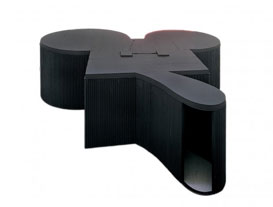
Geometric Mouse and the Mouse Museum
Mouse Museum, 1977
Enclosed structure of wood, corrugated aluminum, and Plexiglass display cases containing 385 objects
263 x 950 x 1020 cm
Museum moderner Kunst Stiftung Ludwig, Vienna.
Photo: Heinz Blezen, courtesy Claes Oldenburg and Coosje van Bruggen
“The Mouse, that’s me!” (1) —Claes Oldenburg
Since the early 1960s, Oldenburg has played with the image of the most iconic of all animated characters, Mickey Mouse. In the version of the cartoon character that he created, the Geometric Mouse, Mickey’s form is combined with that of an old movie camera whose square box and two circular film spools mimic his face and ears. As in Oldenburg’s other artworks, this image blends high and low art, but is more personal. The artist has even suggested that the Geometric Mouse is his alter ego: “The Mouse, that’s me!,” he has said.
In 1967, Oldenburg extended the motif of the mouse into a vision for an entire museum building. In a drawing, he suggested that the Museum of Contemporary Art in Chicago redesign its facade in the shape of the Geometric Mouse. This suggestion was unrealized, but in 1977, drawing on his first model for the Mouse Museum (1977)—which was constructed of corrugated cardboard—he built the walls of an actual museum with black-painted corrugated aluminum. As visitors enter, they see that the interior is dark, with only one illuminated vitrine along the walls and two small vitrines marking the mouse’s eyes. (2)
Within the Mouse Museum, Oldenburg arranged a collection of miniature objects that he had amassed over many years, and had first presented as a museum in 1965. In this earlier incarnation, the objects occupied white shelves in his own apartment in the East Village in New York. Originally called the museum of popular art n.y.c., Oldenburg had planned to commission new acquisitions for the space and to publish a bulletin. (3) The collection consists of 385 objects––including kitsch, toys, souvenirs, and prototypes for his own artworks––all smaller than 87 cm and of three types: 1) fragments and small models from Oldenburg’s working process, 2) objects that he found or bought and then altered, and 3) objects that he found or bought and did not alter. Oldenburg’s second wife and collaborator, Coosje van Bruggen (1942–2009), wrote that the collection offers a glimpse into Oldenburg’s working method and his perception of American society. Each object, she says, is “treated in an nonhierarchical way,” and thus maintains its own identity. (4) The objects are arranged according to a loosely associative sequence of Oldenburg’s design, rather than any judgment of importance.
His Mouse Museum collection represents many of the artistic questions that Oldenburg has dealt with throughout his career: unexpected scale, mutated forms, low art as high art, found objects, and alternatives to the traditional museum or gallery experience. (5)
1. Jörg Wolfert, Claes Oldenburg: The Sixties exhibition brochure, translated by Cynthia Hall (Vienna: Museum Moderner Kunst Stiftung Ludwig Wien, 2012),p. 14, p. 20.
2. Ibid., pp. 21–22.
3. Ibid., p. 21.
4. Coosje van Bruggen, Claes Oldenburg: Mouse Museum/Ray Gun Wing (Cologne: Museum Ludwig, 1979), pp. 3, 75.
5. Jörg Wolfert, Claes Oldenburg: The Sixties exhibition brochure, p. 23.
Preguntas
Look together at the installation view of Claes Oldenburg’s Mouse Museum (1977). Before telling students the title, ask them what they notice about it. What does the form remind them of? Ask them to imagine seeing the object from above rather than from the side. What do they think the shape would look like? Ask a volunteer to sketch the outline, seen from above, on the board.
Tell students that the object is 263 x 950 x 1020 cm cm in size and, as a class, try to compare the size to something students can envision, such as a truck. Now that they know the size, ask them how they can imagine interacting with the object.
Tell students that this is Oldenburg’s Mouse Museum, an installation that visitors can walk into and within which Oldenbur g has displayed a collection of objects he has amassed for years. Oldenburg based the design of the museum on a character he created, the Geometric Mouse, a combination of Mickey Mouse and an old movie camera. How can students see these two forms combined into the museum’s form?
Oldenburg considers the Geometric Mouse his alter ego. He says: “The Mouse, that’s me!” Ask students to discuss the definition of alter ego and to consider examples from movies or books. (An alter ego is technically a second self, distinct from a person’s normal or original personality, but in comic books it is often thought of as a “secret identity” and in literature it is often thought of as a fictional character similar to the author.) What do they think it says about Oldenburg that he sees the Geometric Mouse as his alter ego?
Oldenburg’s Mouse Museum collection consists of 385 miniature objects, including found objects he has altered, found objects he hasn’t altered, and objects from his artistic working process. Look together at a video showing the collection.
Ask students why they think Oldenburg has spent so much time collecting objects, in particular these types of objects. Why do people collect things? Why do students think artists, especially, collect things?
Oldenburg has said that his collection “shows a kind of encyclopedic view of the world. Within it are all possible dimensions, every shade of feeling. There is art there and a bunch of non-art. It’s like a cross-section of a specific time, a microcosm that poses all possible questions.” (1) Ask students to respond to this quote.
1. Ibid., p. 22.
